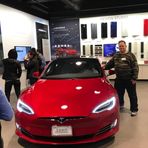Tesla's Robotaxi Reveal: A Glimpse into the Future or Just Hype?
October 11, 2024, 10:34 pm

Location: United States, California, Mountain View
Employees: 1001-5000
Founded date: 2009
Total raised: $13.57B

Location: United States, Texas, Austin
Employees: 10001+
Founded date: 2003
Total raised: $3.86B

Location: United States, California, San Francisco
Employees: 1001-5000
Founded date: 2013
Total raised: $15.26B
Tesla's recent unveiling of its robotaxi, the Cybercab, has stirred a whirlwind of reactions. The event, held in Los Angeles, showcased a sleek vehicle devoid of traditional controls. No steering wheel. No pedals. Just two gull-wing doors and a promise of autonomy. But beneath the glitz, many investors and experts are raising eyebrows.
Elon Musk, the face of Tesla, has a history of ambitious claims. He often paints a picture of a future filled with innovation. Yet, critics argue that the reality often lags behind the vision. The Cybercab is no exception. While the design is futuristic, the details are scant. Investors were left wanting more clarity on production timelines and regulatory hurdles.
The event felt like a magic show. The audience was dazzled, but the tricks behind the curtain remained hidden. Musk's presentation lacked the substance many had hoped for. Questions lingered about the software capabilities of the Cybercab. Industry experts noted that Tesla's software is still playing catch-up with competitors like Waymo and Cruise. These companies have already deployed autonomous vehicles on public roads. Tesla, meanwhile, is still in the conceptual phase.
The two-seater design of the Cybercab has also drawn criticism. It seems impractical for a service aimed at providing door-to-door transport. Who will ride in a vehicle designed for two when families and groups need transportation? The vision of a robotaxi should cater to a broader audience, not just a niche market.
Musk claims that the Cybercab will be significantly safer than human-driven vehicles. He envisions a future where rides cost a fraction of traditional public transport. Yet, the path to that future is riddled with challenges. The absence of radar and lidar raises concerns about the vehicle's ability to navigate complex environments. If the Cybercab can't sense its surroundings, how can it ensure passenger safety?
The operational side of the robotaxi business is another puzzle. How will Tesla manage charging, maintenance, and overall profitability? A vehicle that spends too much time charging is a vehicle that isn't generating revenue. Fast charging solutions are crucial. Without them, the dream of a 24/7 operational robotaxi fleet remains just that—a dream.
Critics have pointed out that the Cybercab's reveal felt like a rehash of past promises. Musk has been touting full autonomy since 2016. Yet, here we are, still waiting for the reality to match the hype. The event echoed sentiments from a decade ago, where grand visions were presented without the necessary groundwork.
Investors are cautious. The lack of concrete details about the Cybercab's production timeline and business model has left many lukewarm. Some analysts predict that significant revenue from robotaxis is still years away. The market is hungry for clarity, but Tesla's announcements often leave more questions than answers.
Tesla's market capitalization is impressive, rivaling that of all other automakers combined. Much of this value is built on the promise of future innovations. However, as competitors make strides in autonomous driving, Tesla's position is becoming precarious. The Cybercab may be a step forward, but it feels more like a step in place.
The Robovan, another vehicle showcased at the event, offers some promise. Designed to accommodate up to 20 passengers, it could serve various transportation needs. Yet, like the Cybercab, it lacks a clear launch timeline. The absence of details leaves potential customers and investors in the dark.
As Tesla continues to develop its humanoid robot, Optimus, the focus on robotics adds another layer to the company's ambitions. But the question remains: can Tesla deliver on its promises? The market is watching closely. Investors want to see results, not just concepts.
In the end, the Cybercab reveal was a mixed bag. It showcased Tesla's vision for the future but left many feeling underwhelmed. The glitz and glamour of the event masked the fundamental challenges that lie ahead. As the dust settles, the industry will be watching to see if Tesla can turn its ambitious plans into reality.
The road to autonomy is long and winding. Tesla has the potential to lead the charge, but it must first navigate the obstacles in its path. Investors and consumers alike are eager for a glimpse of the future. Will Tesla deliver, or will it remain a tantalizing mirage? Only time will tell.
Elon Musk, the face of Tesla, has a history of ambitious claims. He often paints a picture of a future filled with innovation. Yet, critics argue that the reality often lags behind the vision. The Cybercab is no exception. While the design is futuristic, the details are scant. Investors were left wanting more clarity on production timelines and regulatory hurdles.
The event felt like a magic show. The audience was dazzled, but the tricks behind the curtain remained hidden. Musk's presentation lacked the substance many had hoped for. Questions lingered about the software capabilities of the Cybercab. Industry experts noted that Tesla's software is still playing catch-up with competitors like Waymo and Cruise. These companies have already deployed autonomous vehicles on public roads. Tesla, meanwhile, is still in the conceptual phase.
The two-seater design of the Cybercab has also drawn criticism. It seems impractical for a service aimed at providing door-to-door transport. Who will ride in a vehicle designed for two when families and groups need transportation? The vision of a robotaxi should cater to a broader audience, not just a niche market.
Musk claims that the Cybercab will be significantly safer than human-driven vehicles. He envisions a future where rides cost a fraction of traditional public transport. Yet, the path to that future is riddled with challenges. The absence of radar and lidar raises concerns about the vehicle's ability to navigate complex environments. If the Cybercab can't sense its surroundings, how can it ensure passenger safety?
The operational side of the robotaxi business is another puzzle. How will Tesla manage charging, maintenance, and overall profitability? A vehicle that spends too much time charging is a vehicle that isn't generating revenue. Fast charging solutions are crucial. Without them, the dream of a 24/7 operational robotaxi fleet remains just that—a dream.
Critics have pointed out that the Cybercab's reveal felt like a rehash of past promises. Musk has been touting full autonomy since 2016. Yet, here we are, still waiting for the reality to match the hype. The event echoed sentiments from a decade ago, where grand visions were presented without the necessary groundwork.
Investors are cautious. The lack of concrete details about the Cybercab's production timeline and business model has left many lukewarm. Some analysts predict that significant revenue from robotaxis is still years away. The market is hungry for clarity, but Tesla's announcements often leave more questions than answers.
Tesla's market capitalization is impressive, rivaling that of all other automakers combined. Much of this value is built on the promise of future innovations. However, as competitors make strides in autonomous driving, Tesla's position is becoming precarious. The Cybercab may be a step forward, but it feels more like a step in place.
The Robovan, another vehicle showcased at the event, offers some promise. Designed to accommodate up to 20 passengers, it could serve various transportation needs. Yet, like the Cybercab, it lacks a clear launch timeline. The absence of details leaves potential customers and investors in the dark.
As Tesla continues to develop its humanoid robot, Optimus, the focus on robotics adds another layer to the company's ambitions. But the question remains: can Tesla deliver on its promises? The market is watching closely. Investors want to see results, not just concepts.
In the end, the Cybercab reveal was a mixed bag. It showcased Tesla's vision for the future but left many feeling underwhelmed. The glitz and glamour of the event masked the fundamental challenges that lie ahead. As the dust settles, the industry will be watching to see if Tesla can turn its ambitious plans into reality.
The road to autonomy is long and winding. Tesla has the potential to lead the charge, but it must first navigate the obstacles in its path. Investors and consumers alike are eager for a glimpse of the future. Will Tesla deliver, or will it remain a tantalizing mirage? Only time will tell.